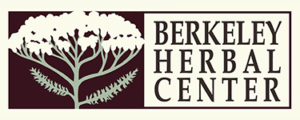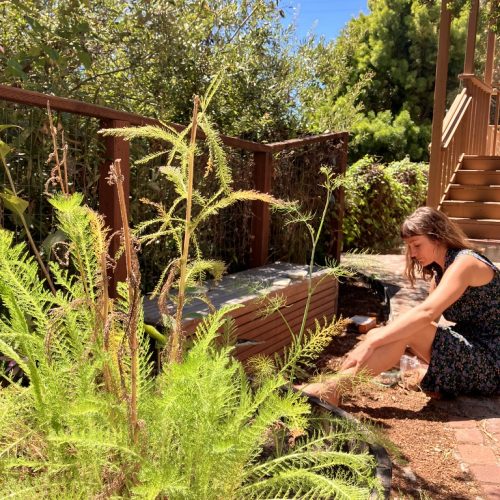
Just a few steps from our classroom overlooking Strawberry Creek, stands the BHC herbal garden.
Students and community members alike can enjoy lunch in the garden, sit on a bench next to yarrow and echinacea, meditate or take a moment to watch pollinators playfully bounce from plant to plant, trailing the essence of our medicinal friends along with them.
The garden brings a new tranquility to every season. In the winter, the sounds of the creek and the smell of our fragrant medicinal herbs swim to the forefront of your senses on a quiet afternoon, providing a feeling of calm and peace. In summer when the creek is moving more slowly, the sound of birds lighting in the trees fill the air while the smell of summer sun on sage leaves brings magic to your meditation.
Not only is it a beautiful, tranquil place to sit quietly with our herbal allies, an herbal garden is a place for teaching.
The garden was established by our Medicine Maker, Rose Birdsong Stuart, with the help of our students. Our garden is a special resource for our students. It gives them hands-on experience with the medicine growing aspect of becoming an herbalist.
“Our aim is to have representation of as many of our medicinal plants as possible so that our students can get to know the plants as living beings and establish deeper relationships with them.” -Kathren Murrell Stevenson
A tenet of our school is to be a shepherd of our planet and to hold reverence for the plants that give us life-changing medicines. Our garden makes it possible for us to demonstrate growth, bring a seasonal focus to healing, and share the energy behind the medicine that we offer to the people that come to the community clinic.
The BHC herbal garden is tended by the medicine-making team and our Apprenticeship students. As a group, apprenticeship students and the medicine making team harvest plants from our herbal garden for medicine-making at our school.
If you’re inspired by the idea of walking outside your home and plucking a flower for your tea, or a spice to go with your dinner, or even harvesting a root to make a tincture – it’s time to consider creating a medicinal herb garden of your own!
This is especially true if you feel called to wild harvesting your medicinals. The planet is having a crisis of climate right now, and she needs every ounce of green space she’s growing. We aren’t here to tell you not to wildcraft. We do, however, want to make it a point to tell you that tending your forest spots while growing your own green herb garden is a more climate, pollinator, and plant friendly way to gather your medicine. Do what you can to take care of endangered plant species while adding more green spaces to the world!
There is something so special about using food and herbs that you have grown yourself to make a meal or a medicine for the people in your life. It takes months, sometimes years, for our plant allies to share themselves and their energy. You can honor them, and honor your own energy, by using the space you have to create your own herbal garden.
There are literally hundreds of medicinal herbs and flowers you can add to a herbal witching garden. This list was hard to narrow down to just six because you can get so much value from so many allies. We chose the herbs below because they are simple to grow, have a lot of uses, and can cover the scale for a large percentage of common ailments.
Here are the 6 herbs we suggest starting with for your herbal garden.
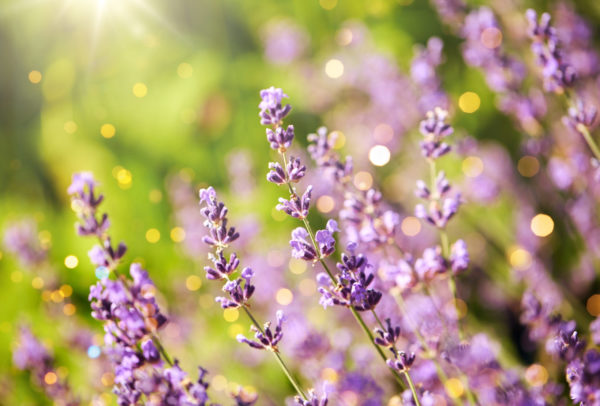
An old stand by – lavender is beautiful in any garden, smells divine, and she has so many uses that you just can’t get enough.
Use her as a strewing herb to ward off fleas, a full flower as a stir stick for your nighttime tea, in every summertime foot soak for a deeper clean, and make a tincture to add to formulas for restful sleep.
Lavender is a perennial, so she flowers every single year. A lovely part about lavender is that the more attention and love and sun you give her, the more she produces for you. Once that plant is in the right spot and has the right pruning scheduled, lavender grows like a wild thing.
Harvesting lavender can happen slowly throughout the warm, sunny season, or you can do two large harvests per year – one at the beginning of the summer, and one at the end.

Always take the time to grow Thyme. He isn’t particularly fast growing in most parts of the world, but he is an evergreen ally that has the cutest tiny flowers in the early summertime.
Not only is fresh thyme a fantastic carminative spice that you will want to add to every dish, you can cook him down with honey (or sugar and water) to make a antimicrobial cough syrup.
The trick with growing thyme in your herbal garden is to keep an eye on him. You want to harvest him often to help him keep his shape. Just don’t cut him back too hard because you can stunt his growth or kill the plant.
The flowers are edible! Garnish with them or make a unique flower essence with thyme that can help you change your relationship with struggle and help your body find itself in transformation.
If you have an herbal garden, growing Mint is a given! She is easy to grow and doesn’t have any qualms about producing her fantastic smelling aerial parts year around in warm climates. In places with the winter season she goes dormant but she is a perennial most of the time.
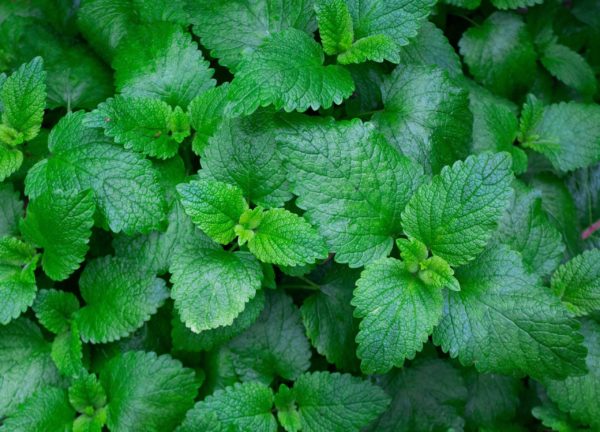
The one caveat with this plant is that she can absolutely take over in the right spot. Mint LOVES water and morning sunshine. She spreads through runners and will wiggle her way into any unprotected part of your garden. Pro tip: grow her in a place you don’t mind being taken over. Consider adding a mix of other great smelling herbs that can take over together! They’ll even each other out and create a mixture of fantastic smells.
Mint can be used in herbal tea blends and foods that you want to add a little carminative action to. When full grown, hang mint in your shower for a lovely sense of deep breath and a touch of personal spa self care. And of course, don’t skimp on the mint in your handmade oils and liniments. Together with lavender and yarrow, your liniments will be balancing, cleansing, and stimulating!
There is no better immediate response or first aid plant than yarrow. And while this is something you can find in just about any field or roadside, you will not regret growing this protection plant in your herbal garden. Yarrow helps contain the energy you want to manifest in the space, and his feathered leaves add another element of beauty to a garden.
You can use him on the cuts and scrapes you get throughout your barefoot summer by chewing up a leaf and sticking it on the cut as a poultice. Dry this friend and use a little bit as a spice when you’re needing a unique bitter flavor in a meal, or make a flower essence to give yourself protection from an outside influence.
Yarrow is a fighter and he will grow where you plant him – and next that, and next to that too. This is easier to maintain than the mints, but you still should watch out. He can turn a well-manicured garden into a field.
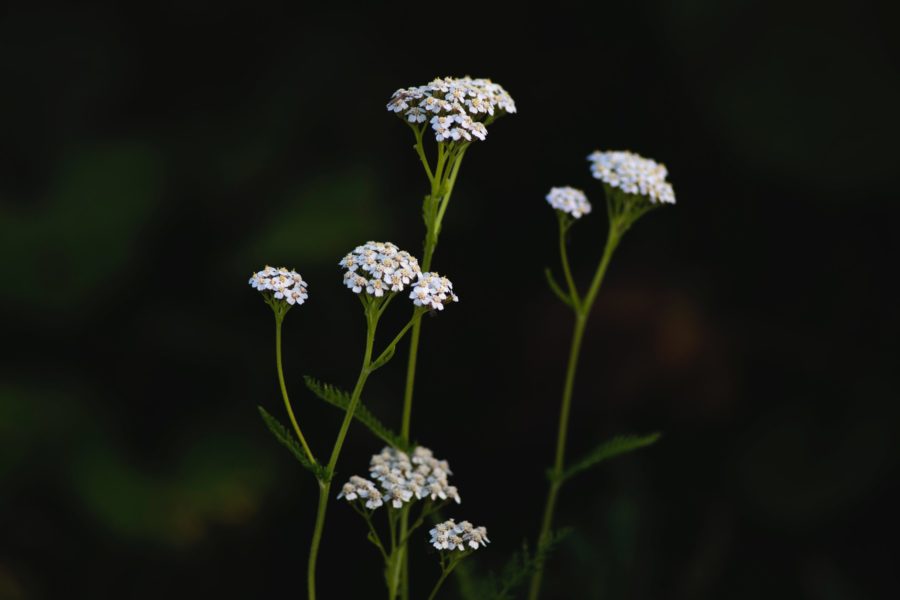
This is the easiest plant to grow on the list. You can transplant him from a roadside ditch or get some from your favorite nursery. Yarrow doesn’t care very much about the amount of water or quality of soil, and he will tolerate moderate light.
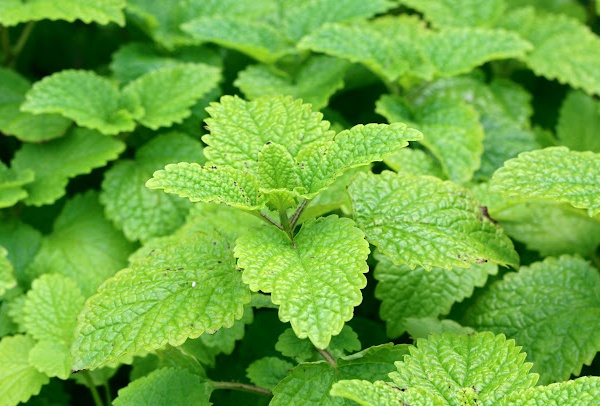
This is a plant you want to grow together with Mint. When they grow side by side, they can get intertwined and oh boy does it smell delish when you run your hands through the mix while you’re walking in your herbal garden.
Lemon Balm loves to spread through runners, he is part of the mint family too, and can be relentless in the same way as his peppermint friend. If you decide to grow lemon balm, make sure to keep this plant trimmed. He can get scraggly and even though he smells great, Lemon Balm lives his best plant life when he has a hard trim back every once in a while.
Lemon Balm makes a lovely pre-date relaxing tea and a bitter you can add to your cocktails or use as an aperitif. Sitting with lemon balm in your garden and breathing her in sweetness can help you feel held in a vulnerable moment when you are searching for inner strength, and of course making a tincture can be a tonic medicine against the winter blues.
Shock. and . Awe. Impress your friends and family by cultivating your own little patch of stinging nettle in your garden! This plant is seen as a pest, an ouchy weed, and a nuisance in most places but she’s an extremely nutritious ally – so give her a place to grow!
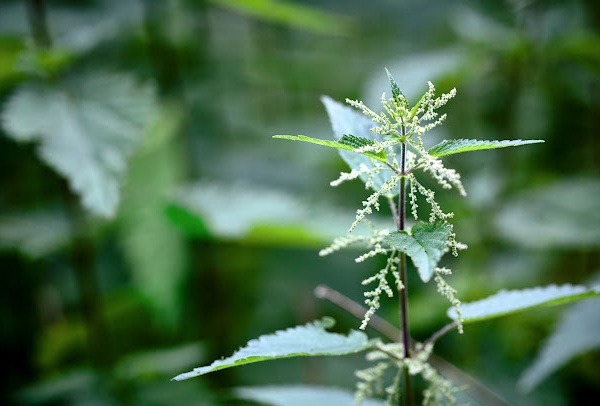
Nettle makes a fantastic food source – and people will be impressed when you fold her into your gnocchi or blend her into a delicious pesto. Nettle decoction makes a lovely diuretic for humans and pets, and a great fertilizer for your garden.
If you decide to grow nettle in your herbal garden, there are a few considerations. We suggest growing her in a place without a lot of foot traffic and with space around her. A healthy, cultivated nettle plant stings, and a happy nettle plant wants to spread out. You have got to keep an eye on your garden and keep the space around her trimmed. If you don’t, you will get stung while you’re harvesting your other plants because they particularly enjoy popping up where you have disturbed the ground, or put other roots.
Are you adding any of these plants to your herbal garden? What else are you planting? Let us know in the comments!
Support Our Work
Berkeley Herbal Center is a 501(c)(3) organization, so all donations are tax deductible. Tax ID #14-1975183
If you would like to donate by check or cash, please send an envelope addressed to:
Berkeley Herbal Center
1250 Addison St., #G
Berkeley, CA 94702
